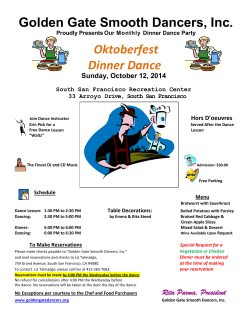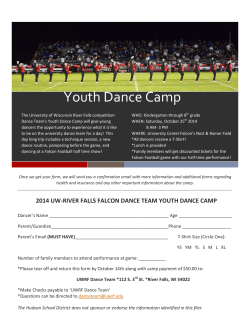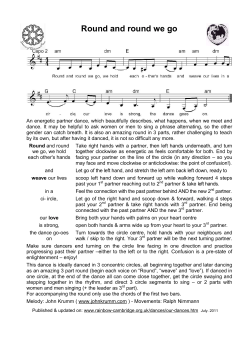
West African Dance
West African Dance Africa Africa, the planet's 2nd largest continent and the second most-populous continent (after Asia) includes (53) individual countries, as well as Western Sahara, a member state of the African Union whose statehood is disputed by Morocco. With just over a billion people (a 2009 estimate) it accounts for just over 14% of the world's human population. It also contains the Nile River system, the world's longest, and the massive Sahara Desert, the world's largest. Africa is surrounded by the Mediterranean Sea to the north, both the Suez Canal and the Red Sea along the Sinai Peninsula to the northeast, the Indian Ocean to the southeast, and the Atlantic Ocean to the west. The continent straddles the equator and encompasses numerous climate areas, and is the only continent to stretch from the northern temperate to southern temperate zones. Africa, particularly central eastern Africa, is widely thought (by science) to be the origin of humans as evidenced by the discovery of the earliest hominids and their ancestors. Geography Region known as West Africa includes along the Atlantic coast the countries of Mauritania, Senegal, Gambia, Guinea, Sierra Leone , Liberia, Ivory Coast, Ghana, Togo, Benin, Nigeria and Cameroon It also includes the island of Cape Verde, Mali, Burkina Faso, Niger and Chad Environments range from desert to dense tropical rain forest Sustenance is mostly derived from fishing, herding, and crop cultivation Quiet villages, urban centers, thriving markets, and desolate outposts Religion Christianity and Islam vie to dominate religious life Political Structures Historically vary from small scale, simply organized communities to widespread kingdoms and empires Today both autocracies and democracies make up political structures In West Africa the French and British dominated in the 19th to mid 20th centuries Portugal controlled Guinea-Bissau and Cape Verde Germany held Togo and Cameroon Liberia created for and settled by freed American slaves has been independent since 1847 Guinea West Africa Guinea, (formerly known as French Guinea) is today one of Africa's poorest countries. It's sometimes called Guinea-Conakry to distinguish it from its nearby neighbor Guinea-Bissau. Guinea belonged to a series of empires until France colonized it in the 1890s, and subsequently France made it part of French West Africa. Guinea finally declared its independence from France on October 2, 1958, and since that independence Guinea has had only two autocratic presidents. Lansana Conte came to power in 1984 when the military seized the government after the death of the first president, Sekou Toure. Guinea did not hold democratic elections until 1993 when Gen. Conte (head of the military) was elected president of the civilian government. He was reelected in 1998 and 2003. Guinea West Africa Unrest in Sierra Leone and Liberia has spilled over into Guinea on several occasions over the past decade, threatening stability and creating humanitarian emergencies. In 2006, declining economic conditions prompted two massive strikes that sparked urban unrest in many Guinean cities. Under French rule, Guinea was a major exporter of bananas, pineapples, coffee and peanuts, but autocratic rulers have all but destroyed that economic engine. Guinea also has 25% of the world's known bauxite reserves, as well as diamonds and gold, but war and political unrest have curtailed those industries as well. West African Dance Dance is common throughout West Africa and takes on many different forms and purposes There are gender and class differences Because African tradition is always changing in relation to time, place, and situation, the dances also change Purposes of Dancing Dance in West Africa conveys feelings, attitudes, concepts, and stories that emanate from everyday life, morality, myth, and legend It also reflects aesthetic and social values and communicates systems of belief Dance plays and educational role providing a way of passing down cultural heritage from adults to children Some dances express social rank. Prestige is usually associated with restrained dance styles. In some tribes/cultures dance promotes healing and is used as preventative medicine Traits of African Dance Polyrhythmic or polycentric The drum is an essential component of African dance The drumbeat provides the rhythm that holds everyone together The drum expresses the mood of the people. It is the sign of life and the heartbeat of the community. The drum provides communities with a sense of belonging and solidarity. African Movement Vocabulary Moves all parts of the body Angular bending of arms, legs and torso; shoulder and hip movement, scuffing, stamping and hopping steps Asymmetrical use of the body, and fluid movement are all a part of African Dance Characteristics The African dancer often bends slightly toward the earth and flattens the feet against it in a wide, solid stance. Improvisation dance is a feature of African Characteristics Many African dances are performed by lines or circles of dancers Solo performers are supported and affirmed by the group through singing, hand clapping, and shouted encouragement Pantomime is used to reflect the motions of life Changes in Dance Forms After Europeans introduced West Africans to university-level education, Western dance styles and theatrical dance forms soon appeared alongside traditional festival, ritual and social events. Professional developed touring companies were Yankadi/Makru Originally yankadi was a seduction dance for young women danced by both young boys and girls coming out on the town to show their new moves It is now danced at various occasions for recreation It is performed at a slow tempo and usually followed by the faster makru tempo Sinte/Kassa Sinte is a rhythm from the region of the city Boke, Boffa and their surroundings. In this part of Guinea, the Landuma and Nalu people are present and use this rhythm as a pre-initiation dance. It has now become very popular because of its melody and the variety of dances associated with it. Kassa is a family of rhythms associated to the harvest. When people from the villages work in remote fields drummers play for them all day long, they are accompanied by women singing throughout the working day. Guest Artist Melinda Bring Phillips – April 5th and 6th dance clothes – NO JEANS You will be required to dance barefoot http://futurpointedance.org
© Copyright 2025










